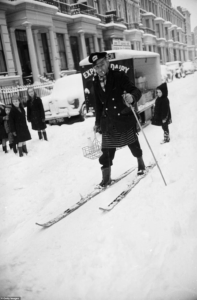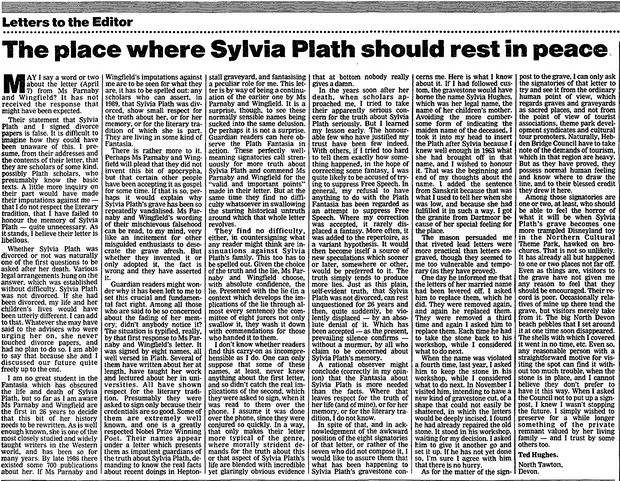 Sylvia Plath was born on 27th October 1932 in place called Jamaica Plain in Boston Massachusetts in the United states. She described her family as being first generation American on one side and second generation American on the other side. Her family were German Austrian Immigrants. Her mother was Aurelia Frances Plath née Schober and her father was Otto Emil Plath. Her father Otto foreshadowed his daughter’s future literary career as he was also a published author. He wrote ‘Bumble Bees and Their Ways’ in 1934 and was an expert in bee keeping. In fact, later in life Sylvia learned the art of bee keeping and references to bees can be seen in her work. Sylvia’s father who was born in Grabow, Germany died in November 1940 and the effect on her was profound. Much of Sylvia’s work was influenced by his death, notably the poem ‘Daddy’.
Sylvia Plath was born on 27th October 1932 in place called Jamaica Plain in Boston Massachusetts in the United states. She described her family as being first generation American on one side and second generation American on the other side. Her family were German Austrian Immigrants. Her mother was Aurelia Frances Plath née Schober and her father was Otto Emil Plath. Her father Otto foreshadowed his daughter’s future literary career as he was also a published author. He wrote ‘Bumble Bees and Their Ways’ in 1934 and was an expert in bee keeping. In fact, later in life Sylvia learned the art of bee keeping and references to bees can be seen in her work. Sylvia’s father who was born in Grabow, Germany died in November 1940 and the effect on her was profound. Much of Sylvia’s work was influenced by his death, notably the poem ‘Daddy’.
Sylvia was one of the oldest of two children with her brother Warren arriving when she was still two years old in 1935. although unconnected, unfortunately the arrival of warren precipitated the start of Otto Plath’s health problems. Otto Plath had mistakenly attributed his own health problems and symptoms to lung cancer, so much so that he never sought medical help until it was too late. In October 1940, Otto had his leg amputated due to diabetes. Unfortunately, he was diagnosed with advanced diabetes and he died a month later. During his last weeks of life, the nurse looking after Otto, employed Sylvia as her assistant nurse.
 Otto Plath died shortly after Sylvia’s 8th birthday and incidentally, Sylvia had her first poem published when she was just 8 and a half years old in the The Boston Traveller. Her father’s death was a major turning point in her life and she later said in an interview that she was happy until the age of 9. After the age of 9, she said that she stopped believing in magic, elves and Santa Claus. She said that she became realistic and depressed. she had prayed constantly for her father’s recovery and this led to a loss of faith in the young Sylvia.
Otto Plath died shortly after Sylvia’s 8th birthday and incidentally, Sylvia had her first poem published when she was just 8 and a half years old in the The Boston Traveller. Her father’s death was a major turning point in her life and she later said in an interview that she was happy until the age of 9. After the age of 9, she said that she stopped believing in magic, elves and Santa Claus. She said that she became realistic and depressed. she had prayed constantly for her father’s recovery and this led to a loss of faith in the young Sylvia.
Four years before her father’s death Sylvia and her family had moved from Jamaica Plain in Massachusetts, to 92 Johnson Avenue, Winthrop also in Massachusetts. It was in Winthrop where Sylvia’s literary talents flourished. Winthrop is located on the northern coast of Massachusetts and during her childhood she spent much of her time by the sea. References to the sea appear many times during her life and in the film of her life, Gwyneth Paltrow who played Plath is shown considering the danger of the sea on more than one occasion. Plath talked about her grandparent’s house in Winthrop and seeing hurricanes and sharks washed up in the back garden. The environment was a rich source for her poetry.
Sylvia attended Gamaliel Bradford Senior High School which is now better known as Wellesley High School. She graduated in 1950 and shortly after achieved her first publication in a national newspaper, namely the Christian science Monitor. It was also in 1950 that she enrolled in Smith college.
During her third year at Smith college, Sylvia won a prestigious guest editorship of Mademoiselle magazine in New York which included spending a month in New York City. It was during this month that Sylvia’s mental health took a turn for the worse. New York city hadn’t lived up to her expectations. She had apparently been promised a meeting with her idol Dylan Thomas which never transpired. the book ‘The Bell Jar’ is semi biographical and relates to this period in her life with ester Greenwood winning a competition and also visiting New York City and a resulting breakdown. It was during 1953 that Plath made her first ‘documented’ attempt at suicide following electro convulsive treatment which is also referred to in the book.
Sylvia Plath and Ted Hughes
In February 1956 Sylvia Plath met her future husband at a party and famously bit his cheek. Some four months later they were married. The couple had met when Ted Hughes was twenty five years old and Sylvia Plath was twenty three years old. Because Ted came from Mytholmroyd in the North of England and Sylvia came from Jamaica Plain, Boston in the United States, the marriage was initially a transatlantic one with Sylvia eventually moving to England.
 The relationship between the two was a torrid and tumultuous one with many fans and supporters of Plath blaming Hughes for Plath’s eventual suicide. His extra marital affair with Assia Wevill some six years into their marriage is now a matter of public record but in recent years there have been reports of letters surfacing, written between Plath and her therapist Dr Ruth Barnhouse. The letters thought to have been written between 18th February 1960 and 4th February 1963 claim domestic abuse by Hughes which had led to the miscarriage of their second child. Hughes is also reported to have told Plath that he wished her dead. The letters and allegations contained therein were reported by the Guardian newspaper in an April 2017 article.
The relationship between the two was a torrid and tumultuous one with many fans and supporters of Plath blaming Hughes for Plath’s eventual suicide. His extra marital affair with Assia Wevill some six years into their marriage is now a matter of public record but in recent years there have been reports of letters surfacing, written between Plath and her therapist Dr Ruth Barnhouse. The letters thought to have been written between 18th February 1960 and 4th February 1963 claim domestic abuse by Hughes which had led to the miscarriage of their second child. Hughes is also reported to have told Plath that he wished her dead. The letters and allegations contained therein were reported by the Guardian newspaper in an April 2017 article.
That Shadow
“that shadow would marry this shadow, and the peculiar, yellowish soil of our locality seal the wound in whiteness and yet another snowfall erase the traces of newness in Joan’s grave.” – ‘The Bell Jar’ chapter 20
 England in December 1962 was deluged with snow, it was a winter like no other, a blizzard had blanketed the country especially Wales and the South East including London where Sylvia and her two children Frieda and Nicholas were living in Primrose Hill. The cold snap continued over the Christmas period and into the new year with January 1963 being the coldest month of the twentieth century. It was so cold, the sea off the coast of Kent froze
England in December 1962 was deluged with snow, it was a winter like no other, a blizzard had blanketed the country especially Wales and the South East including London where Sylvia and her two children Frieda and Nicholas were living in Primrose Hill. The cold snap continued over the Christmas period and into the new year with January 1963 being the coldest month of the twentieth century. It was so cold, the sea off the coast of Kent froze
February 1963, the snow continued to fall and gale-force winds pounded the country. It was in the tumult, the calm winter backdrop that Sylvia Plath wrote poetry large on the white London landscape with her final act. On February 11th 1963, Sylvia Plath prepared food for her two young children, she ventilated their bedroom window and sealed their bedroom door shut with tape so that no fumes could enter. Afterwards she entered the kitchen and turned on the gas oven and placed her head inside. At thirty years old, her life had come to an end.
In the ensuing years, much has been said about her reasons for her final act. Many have sought to blame her estranged husband at the time, Ted Hughes. Others have sought to blame the other woman Assia Wevill implicated at the time or both. Assia was pregnant with the child of Ted Hughes at the time and in the film called ‘Sylvia’, this was given as the reason for Ted not returning to the marriage. Whilst others point to Sylvia having suffered fro depression before ever meeting Ted Hughes and that her suicide was always inevitable.
After Sylvia’s death, Ted Hughes moved Assia Wevill into Court Green, the property in North Tawton, that he had shared with Sylvia to help him look after the two young children. Ted later faced a huge criticism for bringing Assia to Sylvia’s former home. Assia aborted the child that she was carrying but soon became pregnant again and two years after Plath’s death in 1965, whilst still married to her husband David Wevill, Assia gave birth to Alexandra Tatiana Elise Wevill. she was given the surname of her husband David and Ted Hughes never publicly acknowledged that Alexandra Tatiana Elise or ‘Shura’ for short was his daughter, but Olwyn the sister of Hughes said that he always believed that Shura was his daughter.
It was reported that Assia did not cope well with the new circumstances and some suggest that she became overshadowed, overwhelmed and haunted by Plath’s fame and memory. She also became suspicious has Plath had been, of Hughes’ fidelity or lack of it. Hughes later started an affair with a married woman by the name of Brenda Hedden and a nurse called Carol Orchard. Carol was a nurse and twenty years his junior.
All of this was too much for Assia Wevill, and it is often said that fact is stranger than fiction. On March 23rd 1969, in her London home, Assia sealed the doors inside her flat with tape as had Sylvia Plath some six years earlier. She then gave her daughter Shura a drink of water containing an overdose of sleeping pills and then proceeded to turn on the gas stove. The two were later found together on a mattress in the kitchen both dead. Assia was thirty seven years old and her daughter Shura was four years old.
Many years after her death controversy continued to rage over the relationship between Ted Hughes and Sylvia Plath. so much so that the controversy even included her burial place and her grave. In fact Hughes had to address this issue in a newspaper after complaints were made by a Julian Parnaby and a Rachel Wingfield who had complained to the same newspaper (The Guardian) that Sylvia Plath was in a unmarked grave.
According to Ted Hughes, and there is no reason to dispute his assertion, Sylvia Plath never signed her divorce papers and remained Mrs Ted Hughes until her death. It is the norm in the United Kingdom for a woman to take the surname of her husband and Ted Hughes said in the newspaper article that if had followed custom the name on his late wife’s grave would have read Sylvia Hughes only, the name of their children’s mother. However, Ted Hughes said that he recognised that his wife had achieved great fame and accolades in the name of Plath and that he wished to recognise so. He said that he had no desire to use the more cumbersome form of recognition of a former name such as nee Plath and instead included both surnames on her grave stone as Sylvia Plath Hughes.
Unfortunately, the design of the headstone meant the names were riveted to the gravestone with metal letters and persons unknown repeatedly took it upon themselves to remove the name Hughes from her headstone. An act that was seen by Hughes himself as a slight to their children.
Hughes went on to say that his wife was not in an unmarked grave but after the headstone being defaced for the fourth time he had asked the stonemason to keep hold of the headstone until he decided what to do with it.
Ted Hughes died from lung cancer in 1998 some 35 years after Sylvia. His later years in life continued to be marred in controversy over his marriage with Sylvia. In the United Kingdom Ted Hughes was Poet Laureate , had written children’s books, had translated Ovid & Seneca and along with Philip Larkin was considered to be one of the greatest post war poets. Unfortunately for Hughes, in the United States, Hughes’ relationship with Plath continued to overshadow his abilities as a poet and he is best know in America as the husband of Sylvia Plath.
The Place Where Sylvia Plath Should Rest In Peace

Sylvia Plath was a prolific writer and penned many poems, short stories and books as well as those for children which include The Bed Book – Published (1976), The It-Doesn’t-Matter-Suit – Published (1996), Collected Children’s Stories – Published (2001) and Mrs. Cherry’s Kitchen – Published (2001). Many of her works have been published posthumously which explains the later publication dates. She is however most famous for her only novel ‘The Bell Jar’.
Some of her short stories include:
A Day in June – Written (1952)
Above the Oxbow – Written (1958)
All the Dead Dears – Written (1957 /1958)
Among the Bumblebees – Written (early 1950s)
The Daughters of Blossom Street – Written (1959)
The Day Mr. Prescott Died – Written (1956)
Day of Success – Written (1960)
The Fifteen-Dollar Eagle – Written (1959)
The Fifty-Ninth Bear – Written (1959)
The Green Rock – Written (1949)
In the Mountains – Written (1954)
Initiation – Written (1952)
Johnny Panic and the Bible of Dreams – Written (1958)
Mothers – Written (1962)
The Shadow – Written (1959)
Stone Boy with Dolphin – Written (1957–58)
Sunday at the Mintons’ – Written (1952)
Superman and Paula Brown’s New Snowsuit – Written (1955)
Sweet Pie and the Gutter Men – Written (1959)
That Widow Mangada – Written (1956)
Tongues of Stone – Written (1956)
The Wishing Box – Written (1956)